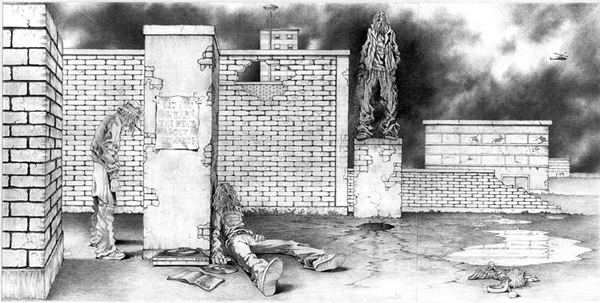
Did you hear the news about Edward?, 2003. Digitalished drawing on paper. 350 x 700 cm. Unique edition. |
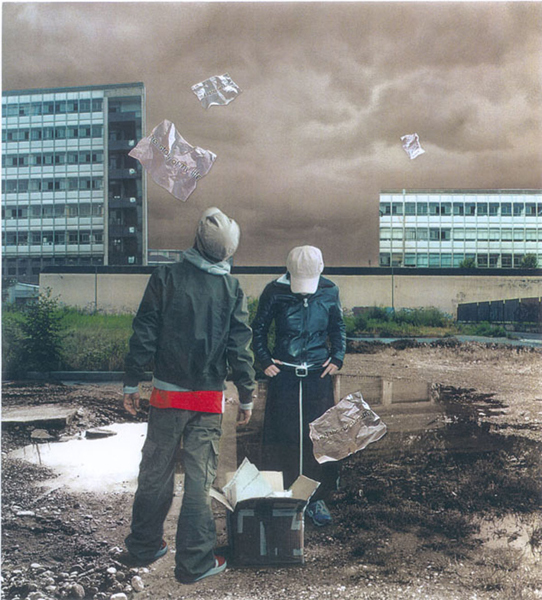
In a suburbian house, 2003. Printing for outside on PVC. 250 x 225 cm. Edición de 2 + A.P. |
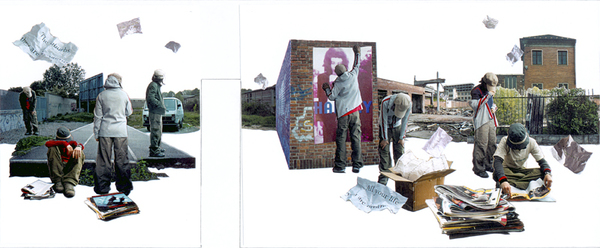
Le periferie che stiamo sognando, 2003. Photocollage on wall. 350 x 860 cm. Unique edition. |
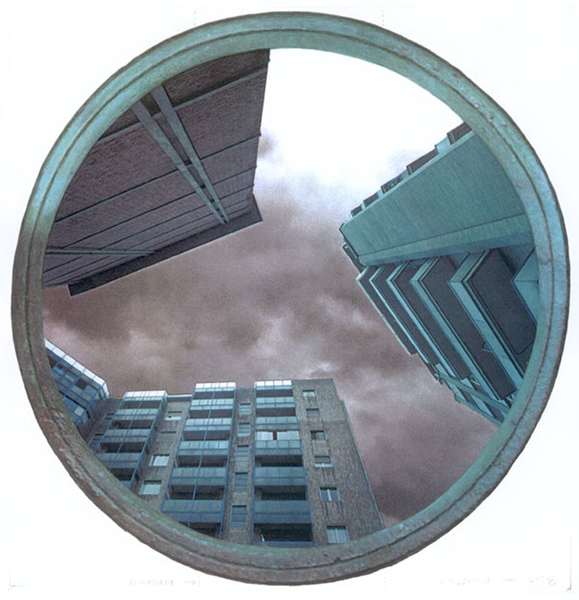
Suburb's hole, 2003. Printing on sticker walkable. 200 cm. diameter. Unique edition. |
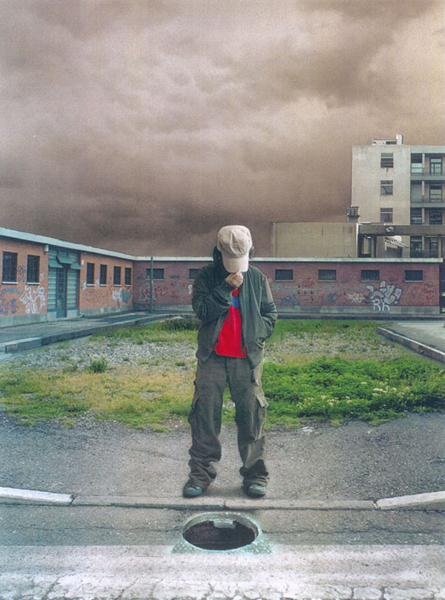
Black hole, 2003. Printing for outside on PVC. 160 x 120 cm. Edition of 2 + A.P. |
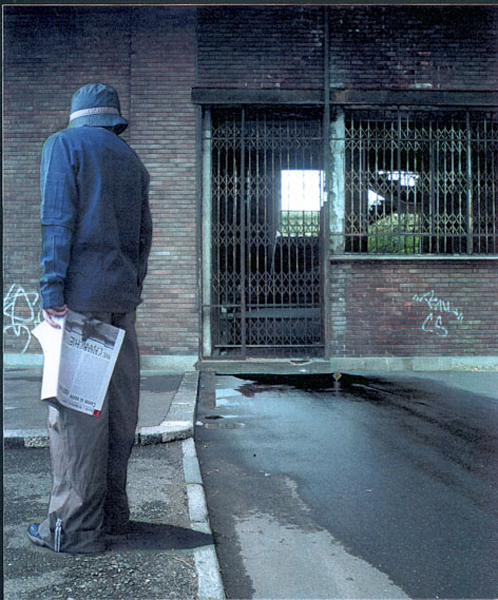
Walking I, 2003. Colour photographic printing on PVC. 100 x 120 cm. Edition of 2. |
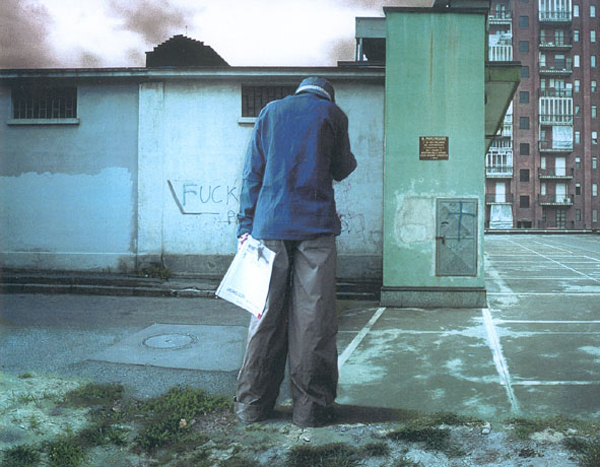
Walking II, 2003. Colour photographic printing on PVC. 100 x 153 cm. Edition of 2. |
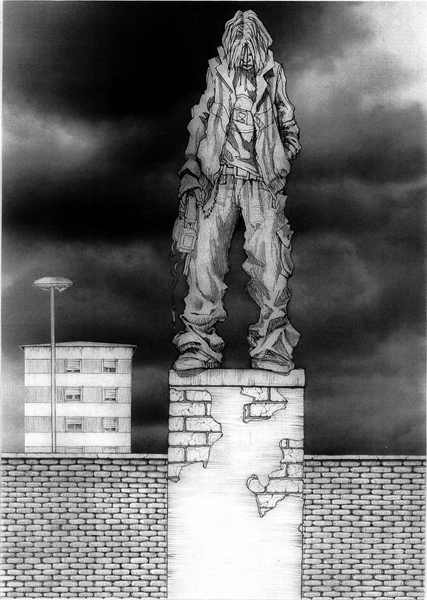
Did you hear the news?, 2003. Drawing printed on paper. 90 x 127 cm. Edition of 2. |
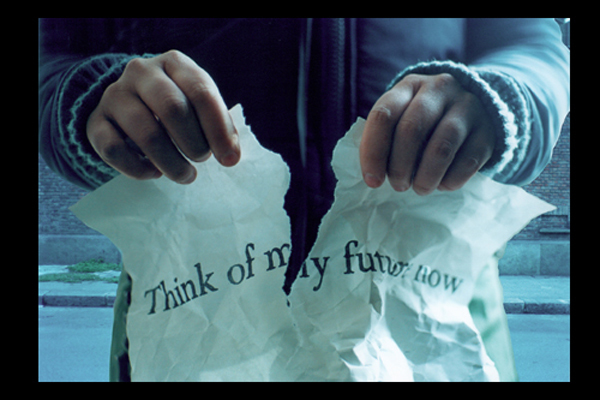
In the same place, 2003. Video. 2' 4". Edition of 5 + A.P. |
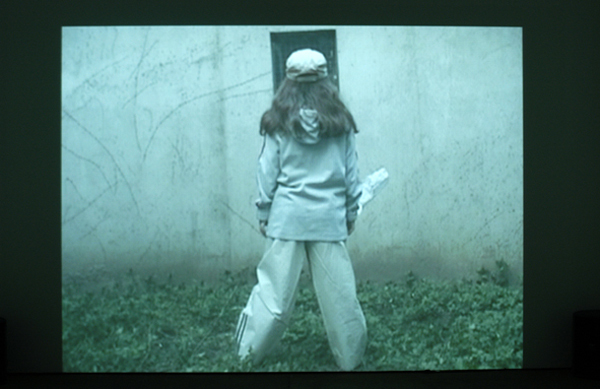
Words place, 2003. Video. 10'. Edition of 5 + A.P. |
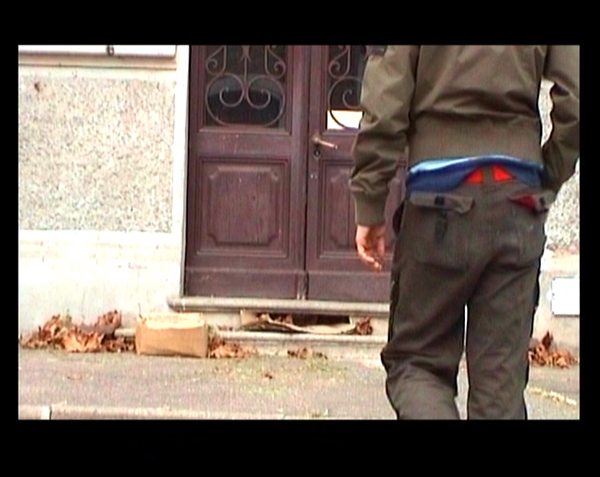
L'arrivo al villagio, 2003. Video. 11'. Edition of 5 + A.P. |
The title refers to the aspects of our peripheries perceived as a myth: a guarding myth from the memory of childhood. A childhood that even in the most unpleasant situations, knows how to find ways to escape and accept the everyday routine. It is the peripheries of the soul that we continue dreaming about, that we want to dream about because we are convinced that it is during this childhood when our actual vision of things is formed. The possibility of conserving memories is what makes adulthood bearable.
Our outskirts are born of a rebellion against the idea that still sees them as places of despair and degradation. Our job is in answer to the model that the media creates, attempting to analyse with complete superficiality the inhabitants’ lives in these immense suburbs where 90% of the population live. The paradox is that he who lives in these suburbs ends up being influenced himself by this stereotyped vision.
We want our work to knock down, even if just for one second, these common places and assure that children that grow up in these places don’t do it with the feeling of being second class citizens, for who the prospect of a better future is denied from the beginning, because growing up with this conviction brings with it the consequence of not being able to even attempt to change things.
Based on these assumptions we began, at the start of the 1990s, to go around the suburbs of our own city, with a Nikon camera and without a fixed objective, encountering roads without pavements and continuing until the crossway, near the river, until nothing else remained but a pylon cable and a house on the horizon.
Thanks to these vagabonds we have rediscovered a much wider aspect of time and a vision of the city that usually, in the everyday life, we never normally come across: one gets in their car or on the bus to go to work, and looks at the city from the window without looking too much at certain places that are unknown to them and therefore deprived of interest. However, some of these places hide the unexpected. In that moment, time and space are prolonged and one can take back their childhood that they believed to be lost.
Normally they are abandoned places that are no longer in use: shut down warehouses near to unknown palaces, sometimes waste grounds with plants that grow up brick walls, schools that you cannot tell if they are still open or not, buildings from the 1960s built for a social function, that we see deteriorate before our very eyes.
We would like, as much as possible, to document this architectural idea that continues disappearing because, for us, these pieces of architecture are alive organisms that come with us especially when they abandon themselves; they were and they are (the few that remain) the necessary iconography for the construction of the myth that was mentioned at the beginning, the stimulus for an untamed imagination, the green oasis of the irrational in a city that some wanted to change from an alive organism to a merchandise machine, useful only for its own profit, where time and space are reduced more and more.
Our work is a kind of ‘docu-fiction’: these photos, that make up a kind of documentary report, are divided into numerous sections: from the industrial architecture, schools, hospitals, brick walls, cloudy skies, autistic people (a boy and girl with their faces covered by a cap and a Hip Hop inspired sports hoodie) to the objects that these people have around them: a hat, a cardboard box that keeps hold of their intimate memories, a cuddly toy, music magazines…
Later these photographs connect together after being cropped and mounted in a collage process that has nothing to do with Photoshop. They are completely handmade photomontages that in our latest mural installations (and in a particular way, as is presented in Gallery Oliva Arauna that takes the title of the exhibition “Las periferias que estamos soñando”) convert into collages directly stuck onto the walls. This becomes visible in the certain areas in previous installations (like the one at the Venice Biennale at the entrance of the corderie in 2001) in the sky and the ground. In this way one is able to see our method of work.
Based on this idea, we have experimented with the idea of dialogue between drawing, photography and collage in the space of the gallery.
Facing the wall with the collage we have devised a large wallpaper drawing inspired by graphic works and underground comics. The title of this piece, “Did you hear the news about Edward”, is inspired by a song by Tom Waits. In this large wallpaper drawing the landscape is reduced down to one wall, some buildings, a puddle of water, a helicopter, a cuddly toy forgotten on the ground and three individuals relaxing listening to music and waiting for something.
On the opposite wall there is a photograph for the exterior on PVC (“In a suburban house”) where this time, the sky and the ground are in black and white while the figures and the architecture are in colour. This work is the result of a montage adjusted by hand to conceal the joining points between one fragment and another, representing the point of union between drawing and collage.
Stuck to the ground is a photographic print that can be walked on, a sewer in which imaginary buildings and a black and white sky are reflected (“Suburb’s hole”).
To finish, in the office, a second photographic print (“Black hole”) in which only the sky is in black and white and a solitary figure observes the black hole of a small open drain, with the same introspective attitude as that of the figure standing on the wall in the wallpaper drawing.
An interest is shown, therefore, in establishing a dialogue between drawing, photomontage and collage, searching for a unity through the expression of diversity.
Botte and Bruno have participated in different international shows from their one in Le Quartier, Centro D’arte Contemporanea di Quimper to their individual shows in el Palazzo delle Esposizioni in Rome in 2000, the Venice Biennale and Art Unlimited in Basel in 2001, the Busan Biennale in South Korea in 2002 and the Geneva Mamco with a photographic exhibition in 2003.
In March 2004 they anticipate an individual exhibition in Nice’s MAMAC. Also in the same year they have won a residence in Paris for the carrying out of a project about the city.

